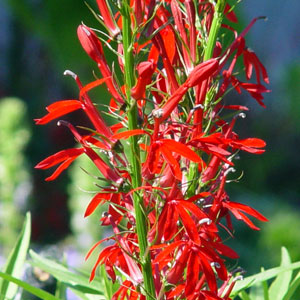Faith Peterson
Adams County Master Gardener
Finally, warm weather has arrived in Adams County. Before you finalize plans for your property, please consider setting aside an area for native plants. You might ask, what is a native plant? A native plant is one which grew here before the arrival of European settlers. There are over 2100 native
species in Pennsylvania which include grasses, ferns, perennials, annuals, biennials, trees, shrubs and vines. A non-native plant is one that has been brought in and becomes established in a given area.
An invasive plant is one that has become a weed pest, growing aggressively and displacing other plants. An article in National Parks magazine in 2006 states, ‘The United States alone spends nearly $140 billion a year to control and eradicate 7,000 invasive species of plants and animals, largely
because of the effect on agricultural crops.’
You can ‘go native’ on your property by following some simple steps. You will be helping to protect native plant communities and minimizing habitat destruction. Natives are tolerant of our local conditions, including native insects; they require minimal watering once established; and they provide
food, shelter and conditions necessary for reproduction of native insects, birds, amphibians, and mammals.
|

The Cardinal Flower reveals its beautiful
red flowers in July. This native does best in wet, partly sunny condition
|
Natives that you can easily incorporate into sunny flower beds include Bee Balm (Monarda), which grows 2 to 3 feet tall and flowers from June to August. It attracts bees and hummingbirds. A spring flowering native is Columbine (Aquilegia). To attract Monarch butterflies, plant milkweed. Asclepias
tuberosa, commonly named Butterfly Weed, is a favorite. Monarch larvae only eat milkweed leaves; and since patches of common milkweed are becoming rare, the Monarchs rely on the milkweed varieties in flowerbeds. There are many different kinds including swamp milkweed for wet areas.
Blazing star (Liatris) blooms mid-summer and attracts all pollinators, including native bees. It has lovely lavender flowers and reaches heights of 24 inches. For fall flowering, consider the many cultivars of our native aster. A cultivar of a native plant is a sub-species. Another sunny garden
favorite, which attracts pollinators and provides seed for birds in late fall and winter is Purple Coneflower (Echinacea). Black-eyed Susan (Rudbeckia), which flowers for 6 weeks or more in mid-summer, has the same attributes as Coneflower.
For those with more space, sunflower (Helianthus) varieties have been developed with multi-stems and lots of flowers, varying heights, and many different colors. They attract native pollinating insects and birds as the seed heads develop. Zinnias and Cosmos are great carefree annual plants which
bloom all summer and attract pollinators, as well as birds that eat the seeds.
One plant that does well in wet, partly sunny conditions is the Cardinal Flower (Lobelia), which grows 2 to 3 feet tall, has beautiful red flowers in July, and attracts hummingbirds. Blue Lobelia grows to the same height and blooms in August and September.
Adding a new native plant area in your yard will save energy, yours and the CO2-type, by reducing your lawn area. A recent editorial in the Evening Sun states that according to the Union of Concerned Scientists, one lawnmower running for one hour emits as much pollution as five new autos driving 55
mph for the same amount of time. If you still need a reason to plant natives, one of the best is that they require much less work, watering, spraying and attention, which allows you to enjoy your garden even more. Don’t forget to include native trees and shrubs in your garden plan.
Read other articles on ecological gardening & native plants